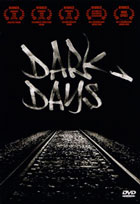
Director: Mark Singer
Duration: 84 minutes
Year: 2001
Key words: Homelessness, poverty, drug dependency
Summary: Mark Singer lives with an established community living in the underground tunnels of the New York subway system, who are subsequently relocated to better housing.
Degree of public health theme coverage: This is a documentary about homelessness in New York City. The major theme is about welfare but the public health issues include the following:
- How these people have drug dependency issues.
- The lack of hygiene – rats, rubbish etc. Eating food from rubbish bins. The community toilet is rather grim!
- Issues around safety (freezing to death, being hit by trains).
- The lack of security eg, a hut being burnt down and huts needing padlocks and “alarm” systems.
- Air quality is poor with the burning of rubbish and cooking fires. Also an official mentions that some of the people have asthma (probably issues around mould/damp/rubbish-related contaminants/rodents).
- Concern about rats and their presence with these disturbing sleep in a hut according to one interviewee.
However, the situation has very unusual aspects – ie, these homeless people are in a railway tunnel and some of them have huts (so is a bit more like a shanty town?). Score=2/5
Sophistication of analysis of public health content: There is not much depth to the actual health issues but the movie gives quite a diverse and in-depth insight into issues around homelessness, poverty and drug use. There are also insights into the attitudes of the homeless to shelter accommodation eg, with these concerning personal freedom, security, and exposure to others using drugs etc. Score=2/5
Potential for empowerment and use of advocacy: There is successful resolution of the homelessness issue in the movie with the residents moving to apartments which they appear to be very happy with. But there is not that much around the process of how this happened. Also there is nothing about whether or not this change meets their long-term needs eg, did they then get jobs and did their drug dependency get treated etc. Also what happened to the relationships with their members of their tunnel “family”?
More indirectly is the fact that the movie director lived in the tunnel and built up trust with the people there. This made making the movie possible. He also actively contributed to making the move to better accommodation possible. Score=4/5
Persuasiveness of the movie: This movie provides a rich understanding of the various issues for these homeless people and the documentary style is convincing. But the message about how the people's lives are improved with better accommodation is not that well developed. Score=3/5
Engagement and cinematic quality: The movie is reasonably engaging and skilfully brought out the humanity of the people involved. Filming just in black and white is effective for this movie. Nevertheless, sometimes it is a bit difficult to understand the language used by the interviewees. Score=3/5
Total score = 14/25
Questions for discussion:
- How is this group of homeless people living in a tunnel different from other groups of homeless people?
- That are the upstream issues that might be causing people to be homeless in large cities?
Other information:
- There is supplementary material on the DVD.
- There is a Wikipedia article on this movie - found here
- The trailer can be seen on YouTube - found here
- Back to Films in Undergraduate Public Health Teaching home page
CONTACT US
Associate Professor Nick Wilson
Department of Public Health
University of Otago, Wellington
PO Box 7343
Wellington South 6242
New Zealand
Tel: +64 4 385 5541 ext 6469
Fax: +64 4 389 5319
Email: nick.wilson@otago.ac.nz